by Texas Homesteader ~
Several weeks back a friend & I were talking about gardening. Her family had a huge garden when she was growing up and they relied on it to keep them all fed.
She was quizzing me on the different things I like to plant in my garden and I rattled off all the faves: Tomatoes, garlic, onion, bell peppers, jalapenos, cantaloupe, squash, green beans, etc.
She asked if I ever planted potatoes and I told her that in the past I’d planted them, but I could never successfully store them long term whether garden potatoes or store-bought. I know that freshly-harvested potatoes have to be cured but even when properly curing them, they would sprout within a short time.
She was surprised that I had any trouble keeping them long term and told me that they just used to store their potatoes on the ground in the barn and they lasted all season. I was intrigued…
I asked her if they lost many of their barn-stored potatoes to critters. But she replied that they never had a problem.
So I asked how they stored the potatoes. Underground? In loose hay? On cardboard? In baskets?
She said they just laid a piece of heavy paper or cardboard right on the dirt floor & piled the potatoes on it. Nothing else was done.
When they wanted potatoes for supper they’d run to the barn & gather a few. They never had problems with sprouting or potato-stealing animals. And their potatoes lasted all season long.
Potato Storage Wisdom
Now usually when I have potatoes I follow all the traditional wisdom. Store in a dark, cool, dry place with plenty of air circulation, away from onions or apples.
I have an airy basket in my walk-in pantry that I always use to store my potatoes. Yet still in no time they begin sprouting.
Experiment: Store Potatoes In Underground Storm Shelter
But now armed with new ideas, I decided to conduct an experiment.
I had just purchased a small bag of potatoes. So I took half of them & stored them in a cardboard box in our underground storm shelter. There temps should stay cool but not too cold, and it’s good & dark.
Store Some Potatoes On Barn Floor
I took some of the rest and stored them on a sheet of newspaper laid on the dirt floor in an area of the barn where the cattle don’t have access.
Then I waited…
Results: Potatoes Stored Underground
Six weeks later I went out to check on things. The potatoes in the storm shelter were still firm but starting to wrinkle. But at least there wasn’t much sprouting going on.
Thankfully the temps underground stay more moderated than temperatures above ground.
Plus in the time that I’d stored them down there we’d had some unseasonably cool weather. I’m sure that helped to keep the temperatures down even better inside the underground shelter.
Potatoes Stored In Barn
The potatoes in the barn were, well, GONE!
Nothing was left except the paper I had laid them upon.
As I had suspected beforehand, some critter has been feasting on the all-you-can-eat buffet that I’ve apparently provided him.
My guess is this is the potato-stealing thief’s address…
So, although the potatoes remained pretty sprout free in the storm shelter, they wrinkled more than I was expecting. Would they really have lasted all season?
I don’t think so. But I’ve heard that you can store potatoes for months on end if you do it right.
I wish I knew the secret! C’mon y’all, hook a sistah up – I need some advice! How do you store your potatoes for the long term to keep them both firm and sprout free?
My Potato-Storage Method
Although how to store potatoes to use all winter long is still a mystery to me, at least I’ve learned a couple of things about storing potatoes:
1) Always remove potatoes from the plastic bags they’re sold in. That plastic bag just allows moisture to accumulate, which speeds rotting. And once one potato begins rotting, it accelerates the rotting of the potato it’s touching, etc.
2) Never store potatoes with onions or apples because those things off-gas which cause the potatoes to sprout more quickly.
Storing Potatoes At Home
So if my potatoes are brought home in a plastic bag, the first thing I do is remove that bag. Then I dump the potatoes out and arrange them in a single layer in a cardboard box lined with newspaper. That paper layer is important.
I try my best to separate them if I can. If there is more than one layer of potatoes I try not to stack them on top of each other. Instead I’ll lay another sheet of newspaper over the first layer of potatoes, then stack the next layer of spuds.
When the potatoes are all spread out and separated by newspaper I cover them all with a final sheet of newspaper. Then I store them on the tile floor in my pantry.
How Did Grandma Get So Smart?
You know, I watched my grandmother do this when I was a kid. Isn’t it amazing that our grandmothers already knew all of this stuff – well before the internet put the knowledge at our fingertips?
~TxH~
Other Food Preservation Posts
- Canning Corn
- Crazy Canning Lady – Successes & Failures
- Homestead Hack: Keep That Broccoli FRESH
- Food Waste In America – What Do Those Dates Mean?
- Cherry Gummy-Chews From Excess Garden Zucchini? YES!
- Sweet Refrigerator Pickles
- Preserving The Harvest: Dehydrating Fresh Carrots
- Dehydrating Fresh Pumpkin For Easy Storage
- Dehydrating Spinach To Enjoy All Year Long
- Using A Dehydrator To Preserve Fresh Onions
- Dehydrating & Storing Cabbage
- Bell Pepper Dehydration
- Using A Solar Oven To Dehydrate Garden Produce
- How To Make Dehydrated Blueberry Powder
- Dehydrating Plums
See ALL Food Preservation Posts
Preserving The Harvest Posts
- Making Tomato Sauce
- Canning Fresh Asparagus
- Water-Bath Canning Pears In Light Syrup
- Canning Garden Corn
- Easier Dill Pickles
- One Quart At A Time Refrigerator Pickles
- Keeping Garlic
- Preserving The Harvest: Oregano
- Accumulating Okra When Your Harvest Is Small
- My Simple, Zero-Waste Herb Drying Setup
…And Much MORE!
See All Preserving The Harvest Posts
Dehydrating Posts
- Preserving The Harvest: Dehydrating Fresh Carrots
- Dehydrating Fresh Pumpkin For Easy Storage
- Dehydrating Spinach To Enjoy All Year Long
- Using A Dehydrator To Preserve Fresh Onions
- Dehydrating & Storing Cabbage
- Bell Pepper Dehydration
- Using A Solar Oven To Dehydrate Garden Produce
- How To Make Dehydrated Blueberry Powder
- Dehydrating Plums
See All Our Dehydrating Posts
C’mon by & sit a spell! Come hang out at our Facebook Page. It’s like sitting in a front porch rocker with a glass of cold iced tea – lots of good folks sharing! You can also follow along on Pinterest, Twitter or Instagram.
If you’d like to receive an email each time a new blog post goes live it’s EASY to
Subscribe to our blog!

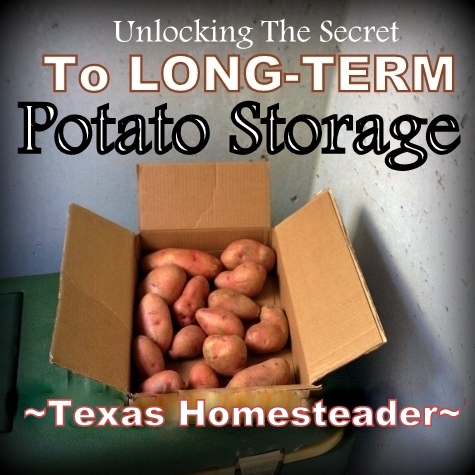
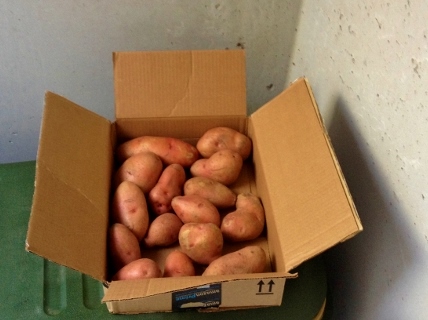
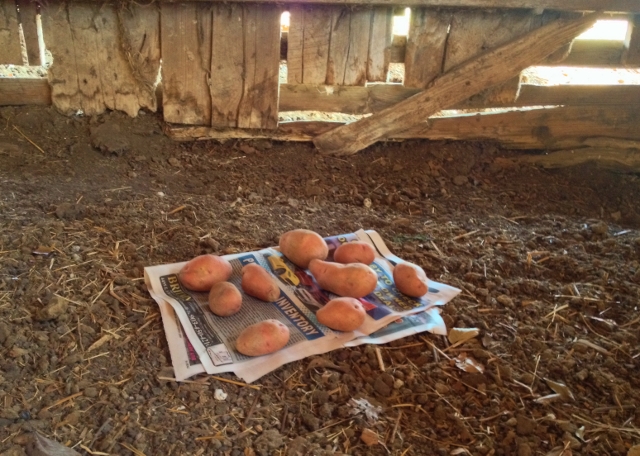
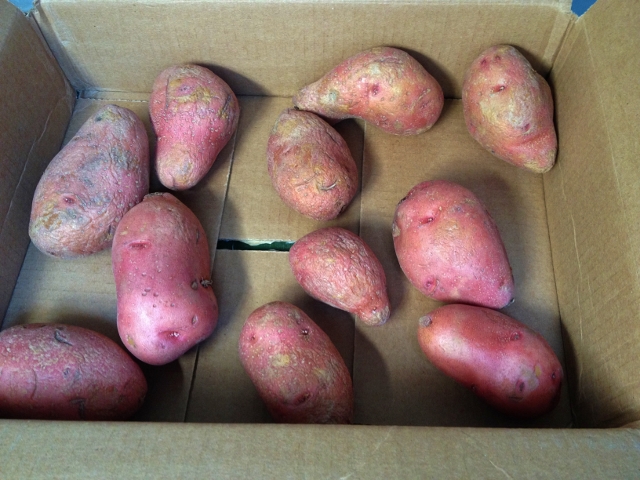
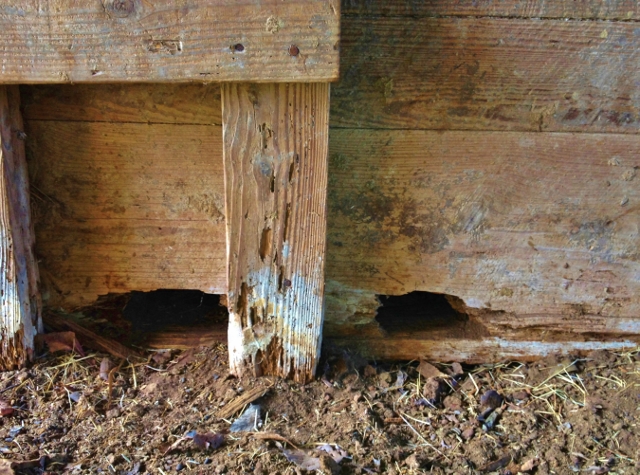
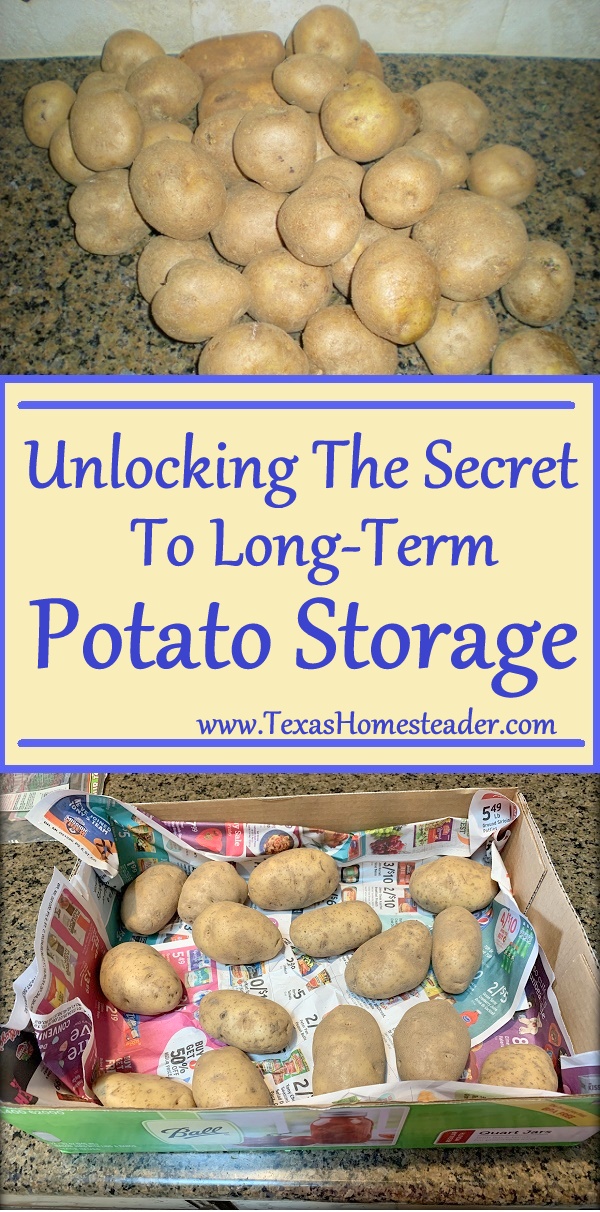


Cool dark and dry seem to be the magic words! Going to try this myself, I always end up throwing potatoes away!
There are some potato varieties that are better for storage than others so ask around if you’re planning to grow. Commercially, they’re stored in climate controlled sheds at 45-50F and 95% humidity with humid air forced up through the storage bins to prevetnt drying and shrinkage. There’s no way you can do that at home although I’ve read lots of stories of how easy it was to keep them good ‘when I was a girl’. I can’t help but think that the view back through the retrospectoscope might be a little rosey!
This is great! Not only was the post good, but the comments are great, too! Thanks again for sharing. I am pinning this!
I missed this post the first time around. Thanks for including it in your top 10 list. I grow potatoes in barrels on my cabin deck. It makes enough for us to eat through the winter and leave for seed potatoes in the spring. My four barrels give a variety of sizes. We eat the smallest first. After letting them dry for several days, I store the medium and large ones. Here’s a link 2013/09/harvesting-and-storing-potatoes.html but basically I wipe any residual dirt off with a paper towel, wrap each one in a square of newspaper and place them in plastic trays with mesh sides. Each tray can hold two layers of wrapped potatoes. I cover the trays with flat newspaper. I moisten a paper towel and put it between the newspaper layers on top and check the spuds each time I take some out to cook. If the paper is try I moisten the paper towel again. I store the baskets under the bed in our guest room near an outside wall. It’s the coolest spot in the cabin even when the woodstove is going to keep us warm in the other rooms. My potatoes last from harvest in the fall through February or March for eating. The rest I let sprout to be my seed potatoes to plant in April. Plus, inside the critters can’t get to them. – Margy
Well, did you ever catch the potato thief? lol Great story. Good luck figuring out the secret, I certainly don’t know it! (we eat our potatoes too quickly for storage to be an issue)
Thanks for linking up with Green Thumb Thursday. I hope to see you back this week!
Lisa
My aunt & uncle grew potatoes every year and we always got a 100# bag. The potatoes were put in what Uncle Doug called “the potato cellar” and I remember that they were just poured in. The room was dug into the side of the hill and had wood walls, ceiling, and floor. It was huge! Probably 30X30 and the spuds were just loose in there. Whoever was buying the spuds bought the burlap bag and then had to fill it themselves. When the bag was full you had about 100# of spuds.
When we got our spuds home, we just stored them in the bag under the basement steps and grabbed whatever we needed for each meal.
This was in southwest Montana 60 years ago.
The one thing I have noticed today is that the spuds we get from the store sprout way early. And it doesn’t really matter how you store them. I even read an article about some twit who is trying to turn good old russets into GMO. He claims to be close even though spuds are already a good as they are going to get.
Cool, dark and dry they say. We keep some in the refrigerator too! We’re big potato eaters!
I store potatoes in wooden bins in the cold room (concrete, like a cellar). The boxes are on castors, so they are off the floor, that might be a factor. I layer them with newspaper, and put a lid on top. Because I live in Canada, the cold room does freeze in winter, so the newspaper insulates them a bit. They do get sweet when they are stored for too long in the cold, I have read that bringing some out and keeping them at room temp for a week reverses that sweet starch problem. My potatoes don’t start to sprout until April or May, which is perfect timing.
Wow!! Ain’t know telling what ate your potatoes. I keep mine in the refrigerator. I have had a bag in there for more than two months now. I just took a few out to cook last Sunday and they were fine. On another note my dad planted peanuts and he said that the cat was in the garden scratching up his peanuts, chewing them up and spitting them out. He was so mad. I have never heard that before.
I blame the opossums. They’re always stealing food around here! lol I’ve actually never managed to grow enough potatoes to store very long. I do grow them in bags though….I wonder what would happen if you just moved the whole bags into the storm cellar?
Thanks for linking up with Green Thumb Thursday. I’d love if you’d link up with us again this week!
~L
Ha! This is such a cute story. I guess the main trick to potato storage is keeping them away from critters!! I have a fairly damp basement and no cold storage, so tend to eat up my potatoes quickly instead. Thanks for joining us at Idea Box. This week’s party goes live Thursday at 6am ET!!
Ha, I was hoping for the heavens to open and an answer to come! 🙂 I also have had bad luck storing potatoes. It makes me sick to throw away the shriveled, sprouted ones at the end of the sack… Hope you print an answer if you finally come into some solid info! 🙂 Thank you for sharing your detective work on the Art of Home-Making Mondays this week.
Potatoes in the garage in California is not an option – day time temps can get 80-90 degrees.
I store small amounts in my bamboo steamer, but at most it holds a few pounds. I don’t grow potatoes for the main reason that there isn’t really a cool dark place to store them unless I try the hall closet.
Saw this on Merry Mondays
I don’t garden myself, but I had a elderly friend who used to simply leave her carrots in the ground all winter and dig them up as needed (I think she cut part of the leaves off in the fall – but I’m not sure – I do know that she left enough to find them again!). If the ground was hard from frost, she’d put straw over the carrot section to keep them “dig-able” It worked great for her. I wonder if it would work for potatoes, too?
As an urban dweller, I keep mine in the fridge when there’s room (and, no, contrary to the myth, it doesn’t spoil the taste. I worked in the restaurant business for a while, and their refrigerated potatoes taste great ; )
If there’s no room, I take my chances with sprouting.
My Mom’s an old farm girl from Sand Mountain AL, and I remember a trick she once described. Native Americans taught it to the settlers way back when. Basically you bury vegetables in the field, laid out in a clockwork style. Potatoes one direction from the center, turnips another, etc. You go to the section of the field where the potatoes are planted to dig up potatoes for example. This relies on the vegetables own metabolism to let them survive the winter. Naturally you don’t do this in the middle of summer, and you are not just leaving them in the ground instead of harvesting, they must be separated from their roots and at least most of their plant. Some, like turnips, actually survive better if you leave about an inch of their stalks attached. Do this in the fall when weather begins to get cooler, after the last harvest.
This next bit is half remembered from an old Foxfire book I read more than 30 years ago. It dealt with storing potatoes in a root cellar. They had trays in the root cellar with, again, dirt in them. The potatoes were put in the trays. Two keys here, don’t let the potatoes touch each other, any that go bad will spread to other potatoes and should be removed immediately when noticed. Also you don’t need to bury them in dirt but nestle them down into it a little. Root plants are adapted to underground survival over the winter, so they can sprout next year. As long as it’s dark and cool/cold they survive longer there than any other method, unless they freeze. Not sure how accurate my memory is about this but it does fit in with what I do know.
Never heard of the apple trick. That sounds good too. If it does keep the potatoes from developing eyes, that would be a big plus.
I plan to take an old freezer and bury it ( hight water table here, too) and use it for a ‘root cellar’ …don’t know if that will prevent withering or sprouting, but I’m trying it anyway!
Now that I have a pot of coffee in me I can think a little better.
I used to do this as well as my mom and that we stored our onions in old pantyhose and don’t know why this wouldn’t work for potatoes as well. ( lets air movement go through and the potatoes aren’t touching each other). Drop in a potato, tie a knot, drop in another potato, tie a knot and so on and they we hung them up on a nail, over a rafter or whatever. By tying a knot between each onion they weren’t touching each other and never received any soft spots
Burlap bags may also work for storing your spuds
I’ve been reading through all the comments- I can’t believe people have so many different ways to store potatoes. I’m stuck in military housing, so a cellar isn’t an option (at least here in WA state). I store mine in a dark cupboard…but I usually leave them in the plastic bag AND it’s in the kitchen.
After reading all these comments, though, I think I’m going to move them to my pantry. And a different bag.
Jennie
p.s. Found your blog via “Wonderful Wednesday Blog Hop” on Recipes for our Daily Bread. Planning on going to check out your Pinterest page right now!
This just cracked me up! I thought you were going to give us the coveted secret to successful potato storage, and instead we get a peek at Templeton’s doorway. Lol. I’ve been trying to figure it out for years. Good luck. I do know that potato farmers around here store them in big barns. Maybe they keep lots of cats on hand. 🙂
It’s funny to see the differences that location makes – if we left potatoes in the barn, they’d spend several months frozen solid and then turn to mush when they thawed. 🙂
For us, seasonal eating with potatoes would be:
Enjoy some tiny new potatoes in July before the main crop.
In September, harvest the potatoes and pig out. Potato season begins.
Around February, they’re getting soft – get out the deep fat fryer and let french fry season begin.
When they aren’t edible anymore, no more potatoes for a while. Time to start working through whatever else is left in the pantry.
The ones that sprout get set aside for planting as soon as the ground is workable in late March.
Until July ….
Well, my parents kept their potatoes in a dark, cool cellar, and Mom says they never lasted into March. Oh – if you want them to last a little bit longer, go through them every few days and pick off any eyes. Unless you’re going to plant them, of course.
Thanks for sharing this post at Good Morning Mondays, we have potatoes to store so the hints are much appreciated. We were thinking of putting them in a wooden box in our shipping container, so we will see how that goes. Blessings
My mother never approved but I have always kept potatoes in one of the vegetable drawers in my refrigerator which will hold about 10 lbs. They keep for an amazing amount of time. It would take quite a few months for them to shrivel or grow sprouts. I know it unconventional but I have always done it that way and I’ve been keeping house for close to 40 years. I have never had a problem and they keep for a good long while.
So what is the difference in storing them in the ‘fridge or a cold place? Seems if cold is the common denominator, that storing them cold ANYWHERE will turn the starch to sugar???
I dunno Carol, that’s just what I’d always heard – that storing potatoes in the fridge makes the starches turn to sugar. Maybe it’s just an old wives tale? (I see a side-by-side experiment in my near future!) I will say that my fridge is set to 35 degrees (I think that’s standard) and since we keep our home pretty warm in the summer our thermostat is set to 78 or so for pantry storage. The coolest outside storage I’d have available to me during spring/summer/fall would be our storm shelter, which may get down into the 70’s – 80’s or so in temperature during our hot/humid Texas summers. That’s a 40-degree (ish) temperature difference between fridge storage and ‘cool’ storage for us, although folks in different regions would have different experiences. I’m excited to read everyone’s suggestions. ~TxH~
I have rotated basement aging potatoes to the refrigerator crisper drawer. (stuffed in a black silk dress) I forgot about them. 2 months months later. I steamed them and they were the best potatoes I have ever eaten. Hooray for starches turning into sugars!
You have hit on one of the universal questions for the ages! I, too, share this problem with early-sprouting potatoes:)
Found your blog on Inspire Me Mondays link party…really enjoyed your post:)
I keep my potatoes in the pump house temp at 38 -40 degrees covered so no light gets to them. Light causes them to turn green. I stored them last Oct. and they are as hard and good as the day I stored them. When the weather gets warm in mid June the start to sprout then.
I don’t know if any of this will be helpful as I live in southern Qregon zone7. Average bottom temp 20 degrees and not much snow in winter. I grow a late crop of potatoes in an big raised bed and for the winter I lay down an 6 inch mulch of leaves on top of the ground and pin a tarp over that and just store the potatoes where they grew. And I go out and pull some out as we need them but our ground doesn’t freeze. It works well in zone 7. Also I have Carole Deppe’s book, “the resilient gardner” and she says she boxes her potatoes in cardboard apple boxes and wraps the boxes in burlap or old blankets and stores in the unheated garage, also in zone 7. You might look into types of potatoes too. Perhaps some of the old variety dryer blue potatoes or the like might store better naturally as modern day varieties aren’t bred for storage. Don’t know if that helped any but I sure enjoy your posts. <3
I live in Zone 7b Connie, so your comments are certainly helpful to me. I’ve never covered the boxes or anything, just stored them loosely in open baskets in my pantry. My main problem I think is during the warmer months, it’s just not cool enough to keep them long term without them sprouting & I’ve always heard not to store them in the fridge as the starches will turn to sugar. So I typically just buy them & focus on consuming them until they’re gone. Sounds like that may be as good as it gets for me. LOL
A dark, cool place with high humidity is good for storing potatoes, but if you want to keep them from sprouting it will take an apple. Where apples cause other fruits and veggies to ripen too quickly, the ethylene gas in apples actually keeps potatoes from sprouting. If you want sprout free potatoes just put an apple or to in your potato bin.
http://www.wikihow.com/Store-Potatoes
Check this out.
Well, I know how you feel. We live in an old farmhouse in Central Louisiana. No air conditioning, and the water level is just a couple of feet down, so no root cellar without a fortune.
I may just try putting them in the barn, in spite of possums and coons.
Hopefully the rat snakes will keep the mice away.
Now I need to just not forget I put them out there!
Thank you!
Well, I know my pantry doesn’t stay anywhere near 40 degrees (which I believe is the optimum storage temp); except in winter.
The friend who first told you about keeping potatoes in the barn, what state does she live in, if I may ask.
Something my son brought up, Louisiana is a humid heat, in the summertime, so not sure if that is a drawback for storage or not.
Thanks for the great post, and have a Blessed Easter. ♥
Linda, my friend grew up in southern Oklahoma, only a short drive from here. I’m wondering if they just went through their potato stash quickly to feed the family. She was a child & didn’t really pay attention to any of the details so perhaps that’s the case. She did call her father when I questioned her about the specifics of barn storage & he clarified the conditions for the barn.
I can think of so many things I wish I had paid more attention to as a child.
Maybe I’ll cut a hole in the floor and store them under the house!
Thank you again and have a great day.
Tammy, I make sure mine are dry and then place them in a paper grocery bag. I fill the bag up about 1/2 full (fold the top of the bag down) and use another after that. I then take the bags and place them in a large pickle crock. The crock is in hall pantry with a shared garage wall. I’m been doing this for years and have had wonderful luck! I also have a small dish of baking soda in there for any odor and not sure if that has anything to do with my luck or not.
May you and your family have a wonderful Easter!! Patti
I have pretty good luck w/our potatoes. I put them in the garage, in a wooden box after they have dried out(curing), and be sure to dry away from the sun. I put them in and after the weather gets really cold, down in low 30’s and 20’s, I throw an old blanket on top..just in case It gets to freezing point in garage. I keep a watch on the cat’s water, if it has ice on it, check the potatoes! so far no problem. but as winter progresses, the potatoes will naturally start to sprout. nature doing it’s thing 🙂 just peel & eat the sprouts do not harm the potato. thing is by feb, the do start sprouting, getting ready to be planted. my seed potatoes I use yr after yr. good luck
Hi Tammy. I really enjoy reading your blog. I’ve learned a lot! We are working on the “potato issue” right now, too. My husband built a wood and wire box in the mudroom. We are waiting to see how it goes.
I “think” I’m doing everything right, but dang I can’t keep potatoes (home grown or commercial) from sprouting quickly. There must be a secret! ~TxH~
Looks like something had quite the feast. Wild boars, field mice, raccoons and even white-tailed deer could had eaten your potatoes.
Keep them dark, and keep them cool, dark and well ventilated place.
Don’t store them near onions, bananas, or other fruit — this will encourage them to sprout faster.
If you have a dark, cool closet away from the heat of the kitchen, store them there or on the top step of your basement stairs. Also, it’s best to take them out of the plastic bag and put them in a basket or breathable cotton sack, wire basket or brown paper bag with the top of the bag rolled down but don’t close. Finally, make sure they are totally dry before storing long-term. Damp potatoes will rot or sprout faster.
Before storing spuds, look them over and use any bruised ones first. Since dampness can cause decay, it is best not to wash spuds before storing.
A person could also make a cheap potato bin to store them in.
Me, I store mine in the refrigerator. I know, it’s a no no but I go through them pretty fast making and freezing steak fries, French fries, etc.
Absolutely Colleen, something sure enjoyed the meal(s). I know there’s a skunk family that lives nearby, perhaps under the barn through the holes I showed pictures of. Wonder if skunks are partial to potatoes… LOL. I typically use all the tricks you mentioned, but still my potatoes always spout quickly. The storm shelter potatoes didn’t sprout after 6 weeks and I love that, but they still wrinkled more than I thought they would. (They’re still firm, just wrinkly.) The saga continues… ~TxH~
I just saw someone posting about breathable cotton bags on Google+ the other day. When I asked, she said she sews hers. I think I’m going to try the same thing. But wanted to ask someone else: where do you get yours?
Jennie
Jennie – I got this response from Colleen but she accidentally responded to the comment notification email instead of posting the comments so it wasn’t showing in the comments section on this post (but it’s pretty darn good advice!)
Colleen writes: “UM, if you have old pillow cases that would work and no sewing involved :} or if you ever have a chance to go to a Good Will store that’s also a good place to find old sheets and pillow cases. Old sheets are also good if you want to cover any plants in the winter. It protects them plus they still get air through. Never use plastic tho to cover winter plants but I’m sure you already knew that.
Or if you saved any of them so called net bags that onions, etc. come in, they I think would also work”
Colleen